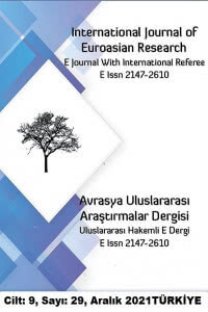TÜRK DÜNYASINDA YÜKSEK ÖĞRETİMİN BUGÜNÜ/GELECEĞİ VE TÜRK DÜNYASIN'DA NİTELİKLİ İNSAN KAYNAĞI SORUNU
Bu çalışmada Türk Dünyası (T.D.) ülkeleri Azerbaycan, Kazakistan, Kırgızistan, Özbekistan, Türkiye ve Türkmenistan’ın güncel nüfus, gelir ve üniversite sayısının durum tespiti yapılmıştır. Metot olarak “Model Taban Mühendisliği (MTM) ve (2n+1) Geometrik Oran Tekniği (GOT)” kısaca “MTM-GOT” kullanılarak yüksek öğretim alanında planlama yapılmıştır. Türkiye ölçek ülke alınarak, diğer Türk Dünyası ülkeleri için gösterge verileri hesaplanmıştır. Türk Dünyasının güncel toplam nüfusu 154,7 milyon ve üniversite sayısı 448 olarak tespit edilmiştir. Türk Dünyası ülkelerinde ortalama 346.000, Türkiye’de 455.000, OIC (Organisation of Islamic Cooperation, OIC) ülkelerinde 627.189 kişiye bir üniversite ve tahmini toplam öğretim üyesi sayısı 173.264 olarak hesaplanmıştır. Türk Dünyası ülkelerinin toplam GDP (Gross Domestic Product, GDP) yıllık milli gelirleri $1144 milyar, kişi başına ortalama milli geliri ise nominal $5476 dolardır. Gelir olarak ABD’nin (%5,582), Almanya’nın (%28,6), Japonya’nın (%23,01), Rusya’nın (%69,71) ve Türkiye’nin ise (%134,43) eşittir. Türk Dünyası ülkelerinin nüfusu, ABD’nin %47’si, Almanya’nın %186,38’i, Rusya’nın %107’si ve Japonya’nın %121,80’ni ve Dünya nüfusunun %2,06’ı Birleşmiş Milletlerdeki devlet sayısının %3 ve Dünya ticaretinin %1,43 ne karşılık gelmektedir. Türk Dünyasının 2050 yılı için tahmini nüfusu 214,92 milyon ve 1/150.000 nüfus oranına göre 1433 üniversite ve toplam öğretim üyesi/öğrenci (1/23) oranı göre 1.433.000 öğretim üyesi, kritik insan kaynağı 8.059.000 olarak hesaplanmıştır. Diğer sayısal göstergeler ise, 850 bilim adamı, 7664 çok üst seviyeli araştırma grup yöneticisi ve 77.146 planlama için insan kaynağına ihtiyaç vardır. Türk Dünyası ülkelerinin 2050 yılı için üniversite mezunu oranı ortalama toplam nüfusun %28 olacağı tahmin edilmektedir.
THE TODAY/FUTURE OF HIGHER EDUCATION IN THE TURKISH WORLD AND QUALIFIED HUMAN RESOURCES PROBLEM IN THE TURKISH WORLD
This study determines the situation of current population, income, and number of universities of Turkish World (T.D.) countries namely Azerbaijan, Kazakhstan, Kyrgyzstan, Uzbekistan, Turkey and Turkmenistan. "Model Base Engineering (MTM) and (2n + 1) Geometric Ratio Technique (GOT)" -briefly MTM-GOT- was used for the planning of higher education field. Indicator data are calculated for the other countries of the Turkish world based on Turkey as the scale country. The current total population of the Turkish World is 154.7 million and the number of universities is 448. On an average, there is a university for average 346,000 people in Turkish World countries; 455,000 people in Turkey and 627 189 people in OIC countries (Organisation of Islamıc Cooperation). The total GDP (Gross Domestic Product, GDP) annual income of the Turkic World countries is $ 1144 billion and the average national income per capita is $ 5476 nominal. Revenue in the US (5,582%), Germany (28.6%), Japan (23.01), Russia (69.71%) and Turkey (134.43) are equal. Population of Turkish World countries corresponds to 47% of the USA, 186.38% of Germany, 107% of Russia, 121.80% of Japan, and 2.06% of the world population. Turkish World countries also corresponds to 3% of the number of states in the United Nations and their trade to 1.43% of the world trade. The estimated population of the Turkish World for 2050 is calculated as 214.92 million, the number of universities as 1433 according to the population ratio of 1/150.000, the total academic staff/student (1/23) ratio as 1.433.000, and academic staff and the critical human resource as 8.059.000. Other numerical indicators show that there is a need for 850 scientists, 7664 multi-level research group managers, and 77,146 human resources for planning. The ratio of university graduates for the year 2050 of the Turkic World countries is estimated to be 28% of the total population.
___
- Birleşmiş Milletler 2005 Raporu, Ülkelerin okur-yazar oranları.
- Education at a Glance 2015. OECD Indicators.
- Education at a Glance 2017. OECD Indicators.
- http://atlas.cid.harvard.edu/rankings, https://oec.world/en/rankings/country/eci/, 2020 http:worldpopulationreview.com/countries/median-age/-Erişim:11 Temmuz 2019.
- IMF 2017 ülkelerin milli gelir raporu.
- OIC Economıc Outlook (2018), Challenges and Opportunities towards Achieving the OIC-2025, October 2018, Statistical, Economic and Social Research and Training Centre for Islamic Countries (SESRIC).
- YILDIRIM Remzi and Mete Gündoğan, (2019) “Model Based Engineering, Optimizing The Higher Education Goals of Turkey’s 2050 Using (2n+1) Geometric Ratio Model”, Journal of Turkish Operations Management, JTOM. 3(1). Pp 259-217,
- YILDIRIM Remzi, (2018) ”Optimization and the Geometric Ratio Model and Its Application to Higher Education In The Future”, American Journal of Engineering Research (AJER), Volume-7, Volume-7, Issue-6, pp-209-214,
- YILDIRIM Remzi, Bülent YEŞİLATA, (2020) “OIC Ülkelerinde Yüksek Öğretime Dayalı İnsan Kaynaklarının Analizi ve Planlaması”, Yüksek Öğretim Bilim Dergisi, Bülent Ecevit Üni. (Kabul edildi) Mart
- YILDIRIM Remzi, Samettin GÜNDÜZ, (2018) “Countries’ Future Higher Education Structure And Optimizing”, American Journal of Engineering Research (AJER), Volume-7, Issue-10, pp-118-138, Statistical Yearbook on OIC Member Countries (2018), Statistical, Economic and Social Research and Training Centre for Islamic Countries (SESRIC).
- T.C. Dışişleri Bakanlığı web:http://www.mfa.gov.tr,Erişim 23 Aralık 2019.
- World Economic Outlook Database April (2019), IMF, www.ımf.org, OECD, oecd.stat.com
- www.4icu.org, uniRank, top University-2018.
- www.comcec.org. Dünya Sağlık Örgütü Raporu (DSÖ) 2019 Raporuna göre-Erişim: Ortalama insan ömrü
- www.oic-oci.org/home/?1an=en
- www.sesric.org/oic-ranker.php, Erişim tarihi: Eylül 2019.
